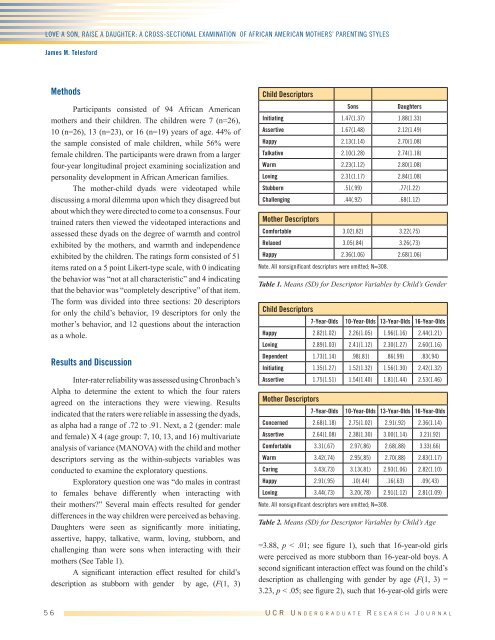Love a Son, Raise a Daughter - University of California, Riverside
Love a Son, Raise a Daughter - University of California, Riverside
Love a Son, Raise a Daughter - University of California, Riverside
Create successful ePaper yourself
Turn your PDF publications into a flip-book with our unique Google optimized e-Paper software.
<strong>Love</strong> a <strong>Son</strong>, <strong>Raise</strong> a <strong>Daughter</strong>: A Cross-Sectional Examination <strong>of</strong> African American Mothers’ Parenting Styles<br />
James M. Telesford<br />
Methods<br />
Participants consisted <strong>of</strong> 94 African American<br />
mothers and their children. The children were 7 (n=26),<br />
10 (n=26), 13 (n=23), or 16 (n=19) years <strong>of</strong> age. 44% <strong>of</strong><br />
the sample consisted <strong>of</strong> male children, while 56% were<br />
female children. The participants were drawn from a larger<br />
four-year longitudinal project examining socialization and<br />
personality development in African American families.<br />
The mother-child dyads were videotaped while<br />
discussing a moral dilemma upon which they disagreed but<br />
about which they were directed to come to a consensus. Four<br />
trained raters then viewed the videotaped interactions and<br />
assessed these dyads on the degree <strong>of</strong> warmth and control<br />
exhibited by the mothers, and warmth and independence<br />
exhibited by the children. The ratings form consisted <strong>of</strong> 51<br />
items rated on a 5 point Likert-type scale, with 0 indicating<br />
the behavior was “not at all characteristic” and 4 indicating<br />
that the behavior was “completely descriptive” <strong>of</strong> that item.<br />
The form was divided into three sections: 20 descriptors<br />
for only the child’s behavior, 19 descriptors for only the<br />
mother’s behavior, and 12 questions about the interaction<br />
as a whole.<br />
Results and Discussion<br />
Inter-rater reliability was assessed using Chronbach’s<br />
Alpha to determine the extent to which the four raters<br />
agreed on the interactions they were viewing. Results<br />
indicated that the raters were reliable in assessing the dyads,<br />
as alpha had a range <strong>of</strong> .72 to .91. Next, a 2 (gender: male<br />
and female) X 4 (age group: 7, 10, 13, and 16) multivariate<br />
analysis <strong>of</strong> variance (MANOVA) with the child and mother<br />
descriptors serving as the within-subjects variables was<br />
conducted to examine the exploratory questions.<br />
Exploratory question one was “do males in contrast<br />
to females behave differently when interacting with<br />
their mothers?” Several main effects resulted for gender<br />
differences in the way children were perceived as behaving.<br />
<strong>Daughter</strong>s were seen as significantly more initiating,<br />
assertive, happy, talkative, warm, loving, stubborn, and<br />
challenging than were sons when interacting with their<br />
mothers (See Table 1).<br />
A significant interaction effect resulted for child’s<br />
description as stubborn with gender by age, (F(1, 3)<br />
Child Descriptors<br />
<strong>Son</strong>s<br />
<strong>Daughter</strong>s<br />
Initiating 1.47(1.37) 1.88(1.33)<br />
Assertive 1.67(1.48) 2.12(1.49)<br />
Happy 2.13(1.14) 2.70(1.08)<br />
Talkative 2.10(1.28) 2.74(1.18)<br />
Warm 2.23(1.12) 2.80(1.08)<br />
Loving 2.31(1.17) 2.84(1.08)<br />
Stubborn .51(.99) .77(1.22)<br />
Challenging .44(.92) .68(1.12)<br />
Mother Descriptors<br />
Comfortable 3.02(.82) 3.22(.75)<br />
Relaxed 3.05(.84) 3.26(.73)<br />
Happy 2.36(1.06) 2.68(1.06)<br />
Note. All nonsignificant descriptors were omitted; N=308.<br />
Table 1. Means (SD) for Descriptor Variables by Child’s Gender<br />
Child Descriptors<br />
7-Year-Olds 10-Year-Olds 13-Year-Olds 16-Year-Olds<br />
Happy 2.82(1.02) 2.26(1.05) 1.96(1.16) 2.44(1.21)<br />
Loving 2.89(1.03) 2.41(1.12) 2.30(1.27) 2.60(1.16)<br />
Dependent 1.73(1.14) .98(.81) .86(.99) .83(.94)<br />
Initiating 1.35(1.27) 1.52(1.32) 1.56(1.30) 2.42(1.32)<br />
Assertive 1.75(1.51) 1.54(1.40) 1.81(1.44) 2.53(1.46)<br />
Mother Descriptors<br />
7-Year-Olds 10-Year-Olds 13-Year-Olds 16-Year-Olds<br />
Concerned 2.68(1.18) 2.75(1.02) 2.91(.92) 2.36(1.14)<br />
Assertive 2.64(1.08) 2.38(1.30) 3.00(1.14) 3.21(.92)<br />
Comfortable 3.31(.67) 2.97(.86) 2.68(.88) 3.33(.66)<br />
Warm 3.42(.74) 2.95(.85) 2.70(.88) 2.83(1.17)<br />
Caring 3.43(.73) 3.13(.81) 2.93(1.06) 2.82(1.10)<br />
Happy 2.91(.95) .10(.44) .16(.63) .09(.43)<br />
Loving 3.44(.73) 3.20(.78) 2.91(1.12) 2.81(1.09)<br />
Note. All nonsignificant descriptors were omitted; N=308.<br />
Table 2. Means (SD) for Descriptor Variables by Child’s Age<br />
=3.88, p < .01; see figure 1), such that 16-year-old girls<br />
were perceived as more stubborn than 16-year-old boys. A<br />
second significant interaction effect was found on the child’s<br />
description as challenging with gender by age (F(1, 3) =<br />
3.23, p < .05; see figure 2), such that 16-year-old girls were<br />
56 UCR Un d e r g r a d u a t e Re s e a r c h Jo u r n a l














